Bringing greenery into your home can create a vibrant and welcoming atmosphere. However, if you’re a cat owner, it’s crucial to choose houseplants that are safe for your feline companions. Cats are naturally curious and may nibble on plants, so ensuring your indoor garden is filled with non-toxic options is essential for their health and wellbeing. Creating a harmonious home where both your plants and your cats can thrive is easier than you think.
Why Choose Cat-Safe Houseplants?
Cats explore their environment through taste and touch, and houseplants are often irresistible to them. While some playful nibbling might seem harmless, many common houseplants are toxic to cats and can cause a range of health issues, from mild stomach upset to severe organ damage. Choosing Cat Friendly Plants eliminates this risk, giving you peace of mind and allowing your cat to explore their surroundings safely. Beyond safety, cat-friendly plants allow you to fully enjoy the aesthetic and air-purifying benefits of indoor greenery without compromising your pet’s health.
Here’s a curated list of 34 beautiful and easy-to-care-for cat safe plants, approved by the ASPCA, to help you create a stylish and pet-friendly home.
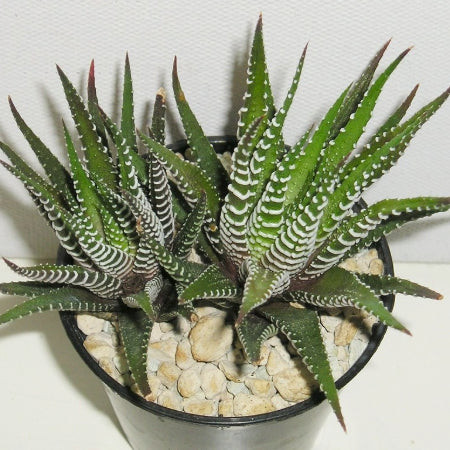 Zebra Plant (Haworthia fasciata) with striking white stripes on dark green leaves, perfect for a cat-friendly home.
Zebra Plant (Haworthia fasciata) with striking white stripes on dark green leaves, perfect for a cat-friendly home.
1. Zebra Plant (Haworthia fasciata)
Key Features:
- Toxicity: Non-toxic to cats and dogs
- Watering: Low; drought-tolerant
- Size: Up to 8 inches tall
- Light: Full sun to partial shade
The Zebra Plant (Haworthia fasciata) is a visually striking succulent with thick, dark green leaves adorned with distinctive white horizontal stripes. Its compact size makes it ideal for shelves, desks, and smaller spaces. This low-maintenance, cat-safe plant adds a touch of modern elegance to any room while ensuring your feline friend’s safety.
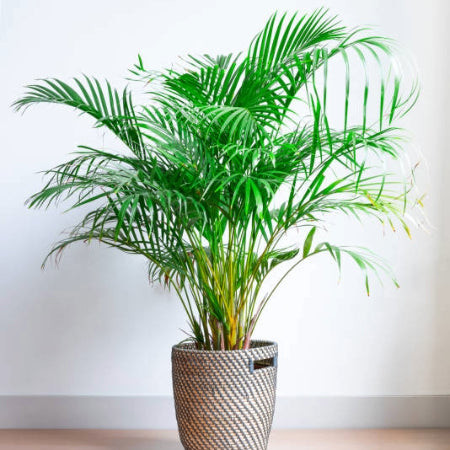 Parlor Palm (Chamaedorea elegans) in a bright indoor setting, a low-maintenance and cat-friendly choice.
Parlor Palm (Chamaedorea elegans) in a bright indoor setting, a low-maintenance and cat-friendly choice.
2. Parlor Palm (Chamaedorea elegans)
Key Features:
- Toxicity: Non-toxic to cats and dogs
- Watering: Low; drought-resistant
- Size: Up to 6 feet tall indoors, 16 feet in the wild
- Light: Low to bright indirect light
The Parlor Palm (Chamaedorea elegans) is a classic and air-purifying houseplant that is also safe for cats. Its graceful, feathery fronds bring a touch of the tropics indoors. This plant is remarkably low-maintenance, thriving in low-light conditions and tolerating infrequent watering, making it perfect for busy cat owners.
 Russian Sage (Perovskia atriplicifolia) with silvery foliage and lavender-blue flowers, a drought-tolerant and cat-safe garden addition.
Russian Sage (Perovskia atriplicifolia) with silvery foliage and lavender-blue flowers, a drought-tolerant and cat-safe garden addition.
3. Russian Sage (Perovskia atriplicifolia)
Key Features:
- Toxicity: Non-toxic to cats and dogs
- Watering: Low; drought-resistant
- Size: Up to 4 feet tall
- Light: Full sun to partial shade
Russian Sage (Perovskia atriplicifolia) is a beautiful and aromatic perennial that is safe for cats and adds lovely silvery-gray foliage and lavender-blue flowers to your home or garden. Known for its drought tolerance and pest-deterring qualities, Russian sage is easy to care for and provides long-lasting color and texture.
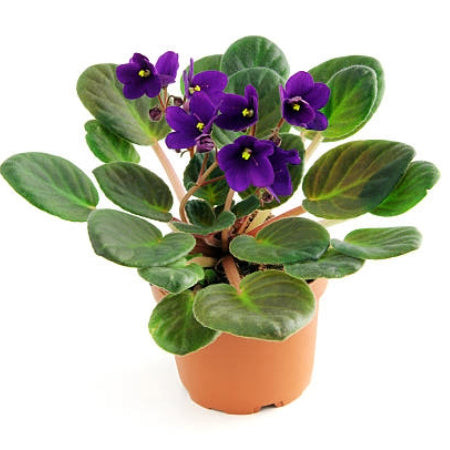 African Violet (Saintpaulia ionantha) with vibrant purple blooms, a colorful and pet-friendly houseplant.
African Violet (Saintpaulia ionantha) with vibrant purple blooms, a colorful and pet-friendly houseplant.
4. African Violet (Saintpaulia ionantha)
Key Features:
- Toxicity: Non-toxic to cats and dogs
- Watering: Moderate; allow soil surface to dry between watering
- Size: Up to 9 inches tall and wide
- Light: Bright, indirect light
African Violets (Saintpaulia ionantha) are beloved for their charming, colorful blooms and soft, velvety leaves. Available in various shades of purple, pink, and white, they bring a touch of cheer to any indoor space. These compact and cat-friendly plants thrive in humid environments and are relatively easy to care for, making them a delightful addition for cat lovers.
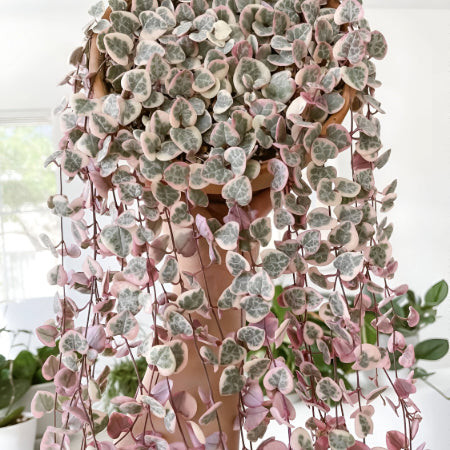 Variegated String of Hearts (Ceropegia Woodii Variegata) trailing with heart-shaped leaves, a whimsical and cat-safe hanging plant.
Variegated String of Hearts (Ceropegia Woodii Variegata) trailing with heart-shaped leaves, a whimsical and cat-safe hanging plant.
5. Variegated String of Hearts (Ceropegia Woodii Variegata)
Key Features:
- Toxicity: Non-toxic to cats and dogs
- Watering: Low; drought-tolerant
- Size: Trailing vines up to 12 feet long
- Light: Bright, indirect light
The Variegated String of Hearts (Ceropegia Woodii Variegata) is a delicate and visually appealing trailing plant. Its cascading vines are adorned with small, heart-shaped leaves featuring beautiful green and white variegation. This cat-friendly plant is perfect for hanging baskets or shelves, adding a touch of whimsy and elegance to your home decor.
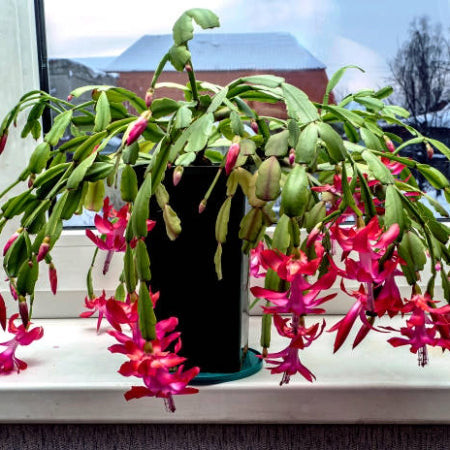 Christmas Cactus (Schlumbergera bridgesii) in full bloom with vibrant pink flowers, a festive and cat-safe holiday plant.
Christmas Cactus (Schlumbergera bridgesii) in full bloom with vibrant pink flowers, a festive and cat-safe holiday plant.
6. Christmas Cactus (Schlumbergera bridgesii)
Key Features:
- Toxicity: Non-toxic to cats and dogs
- Watering: Moderate; allow soil surface to dry slightly between watering
- Size: Up to 12 inches long and 24 inches wide
- Light: Bright, indirect light
Christmas Cactus (Schlumbergera bridgesii) is a festive and easy-to-grow houseplant that is safe for cats. Blooming with vibrant, colorful flowers during the holiday season, it adds a cheerful touch to your home. This low-maintenance plant thrives in bright, indirect light and requires consistent moisture during its blooming period.
 Air Plants (Tillandsia varieties) creatively displayed in glass terrariums, unique and soil-free cat-friendly plants.
Air Plants (Tillandsia varieties) creatively displayed in glass terrariums, unique and soil-free cat-friendly plants.
7. Air Plants (Tillandsia varieties)
Key Features:
- Toxicity: Non-toxic to cats and dogs
- Watering: Mist 2-3 times per week or soak occasionally
- Size: Varies by variety, ranging from small to larger sizes
- Light: Bright, indirect light
Air Plants (Tillandsia varieties) are unique and versatile cat-friendly houseplants that don’t require soil to grow. They come in various shapes, sizes, and foliage colors, offering endless creative display possibilities. Simply mist them with water a few times a week, and they’ll thrive in bright, indirect light, adding a modern and minimalist touch to your home.
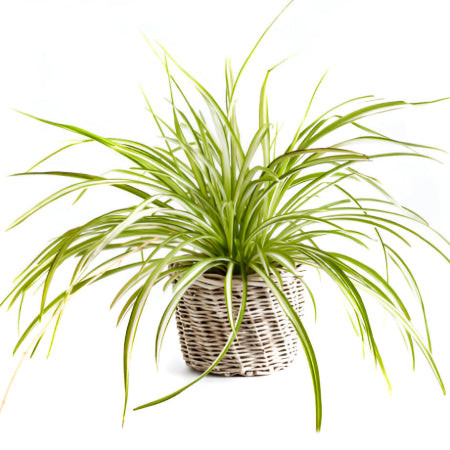 Spider Plant (Chlorophytum comosum) with its characteristic spiderettes, an air-purifying and cat-safe classic houseplant.
Spider Plant (Chlorophytum comosum) with its characteristic spiderettes, an air-purifying and cat-safe classic houseplant.
8. Spider Plant (Chlorophytum comosum)
Key Features:
- Toxicity: Non-toxic to cats and dogs
- Watering: Moderate; allow soil surface to dry between watering
- Size: Trailing foliage up to 2 feet long
- Light: Partial shade to bright indirect light
Spider Plants (Chlorophytum comosum) are incredibly popular, easy-to-grow, and air-purifying houseplants that are also safe for cats. They produce “spiderettes” or baby plants, which can be easily propagated. Spider plants are adaptable to various light conditions and make a great choice for beginners and experienced plant owners alike.
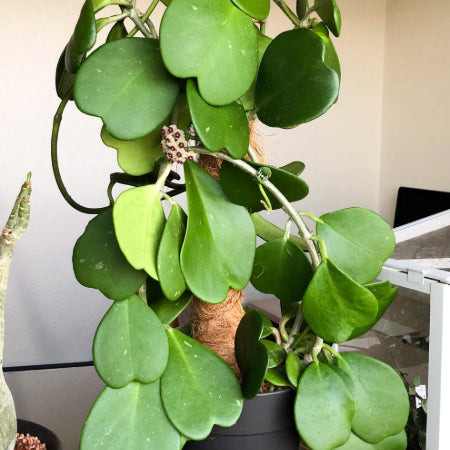 Sweetheart Hoya (Hoya kerrii) with distinctive heart-shaped leaves, a symbolic and cat-safe succulent.
Sweetheart Hoya (Hoya kerrii) with distinctive heart-shaped leaves, a symbolic and cat-safe succulent.
9. Sweetheart Hoya (Hoya kerrii)
Key Features:
- Toxicity: Non-toxic to cats and dogs
- Watering: Low; drought-tolerant
- Size: Trailing vines up to 13 feet long
- Light: Bright, indirect light
Sweetheart Hoya (Hoya kerrii), also known as Valentine Hoya, features charming, heart-shaped leaves, making it a symbolic and visually appealing cat-friendly plant. This low-maintenance succulent is perfect as a single leaf cutting or a trailing vine, adding a touch of love and greenery to your space.
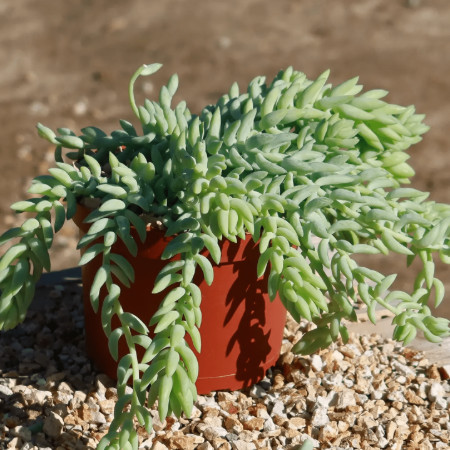 Donkey Tail Plant (Sedum morganianum) cascading with plump, succulent leaves, a textural and cat-safe trailing succulent.
Donkey Tail Plant (Sedum morganianum) cascading with plump, succulent leaves, a textural and cat-safe trailing succulent.
10. Donkey Tail Plant (Sedum morganianum)
Key Features:
- Toxicity: Non-toxic to cats and dogs
- Watering: Low; drought-tolerant
- Size: Trailing stems up to 4 feet long
- Light: Full sun to partial shade
The Donkey Tail Plant (Sedum morganianum) is a fascinating succulent with long, trailing stems covered in plump, fleshy leaves resembling a donkey’s tail. This texture-rich, cat safe plant is perfect for hanging baskets or cascading over shelves, adding a unique and sculptural element to your indoor plant collection.
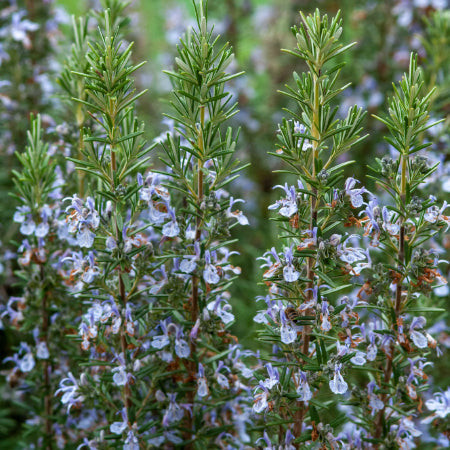 Rosemary (Salvia Rosmarinus) with needle-like leaves, an aromatic and cat-safe herb for the home.
Rosemary (Salvia Rosmarinus) with needle-like leaves, an aromatic and cat-safe herb for the home.
11. Rosemary (Salvia Rosmarinus)
Key Features:
- Toxicity: Non-toxic to cats and dogs
- Watering: Low; drought-resistant
- Size: Up to 5 feet tall
- Light: Full sun to partial shade
Rosemary (Salvia Rosmarinus) is an aromatic evergreen shrub with needle-like leaves and delicate flowers. This culinary herb is also safe for cats and dogs, making it a practical and pet-friendly addition to your home. Rosemary is easy to grow, drought-tolerant, and adds a refreshing fragrance to your space.
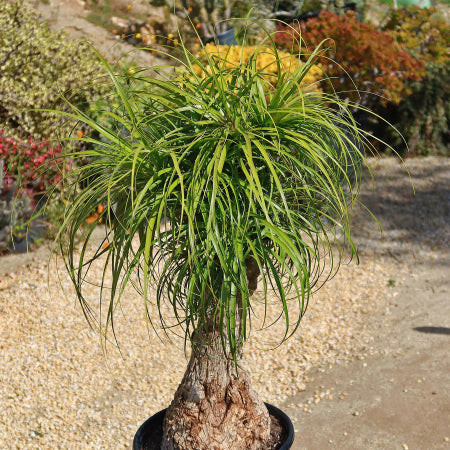 Ponytail Palm (Beaucarnea Recurvata) with its distinctive bulbous trunk and cascading fronds, a statement and cat-safe plant.
Ponytail Palm (Beaucarnea Recurvata) with its distinctive bulbous trunk and cascading fronds, a statement and cat-safe plant.
12. Ponytail Palm (Beaucarnea Recurvata)
Key Features:
- Toxicity: Non-toxic to cats and dogs
- Watering: Low; extremely drought-tolerant
- Size: Up to 11 inches tall indoors
- Light: Full sun to partial shade
The Ponytail Palm (Beaucarnea Recurvata) is a striking and low-maintenance succulent that’s safe for cats and adds a touch of desert charm to your home. Its unique bulbous trunk and long, cascading fronds create a dramatic silhouette. This plant is incredibly drought-tolerant and easy to care for, even for beginners.
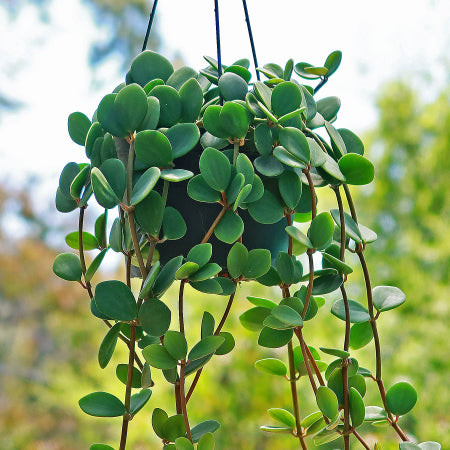 Peperomia Hope (Peperomia tetraphylla) with round, fleshy leaves, a compact and cat-safe peperomia variety.
Peperomia Hope (Peperomia tetraphylla) with round, fleshy leaves, a compact and cat-safe peperomia variety.
13. Peperomia Hope (Peperomia tetraphylla)
Key Features:
- Toxicity: Non-toxic to cats and dogs
- Watering: Moderate; allow soil surface to dry between watering
- Size: Up to 12 inches tall and 8 inches wide
- Light: Partial shade to bright indirect light
Peperomia Hope (Peperomia tetraphylla) is a charming and easy-to-grow houseplant that is safe for cats. Its attractive, rounded, fleshy leaves bring a touch of texture to any space. Peperomia Hope is relatively low-maintenance and thrives in indirect light, making it a wonderful choice for cat owners.
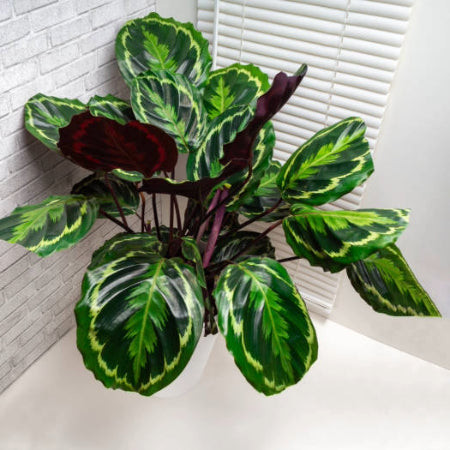 Rattlesnake Plant (Calathea lancifolia) with patterned leaves resembling rattlesnake skin, a visually striking and cat-safe foliage plant.
Rattlesnake Plant (Calathea lancifolia) with patterned leaves resembling rattlesnake skin, a visually striking and cat-safe foliage plant.
14. Rattlesnake Plant (Calathea lancifolia)
Key Features:
- Toxicity: Non-toxic to cats and dogs
- Watering: Moderate; keep soil consistently moist
- Size: Up to 2 feet tall and wide
- Light: Partial shade
Rattlesnake Plant (Calathea lancifolia) is known for its striking foliage with distinctive patterns that resemble rattlesnake skin. These visually captivating plants are also non-toxic to cats and dogs. Calatheas prefer indirect sunlight and consistent watering, making them a beautiful and safe addition to your pet-friendly home.
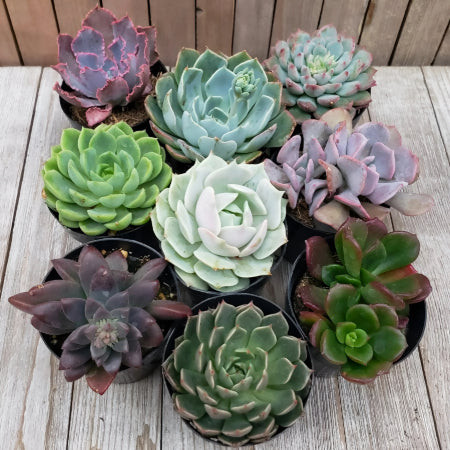 Echeveria (Echeveria spp.) rosettes in various colors, a diverse and cat-safe succulent group.
Echeveria (Echeveria spp.) rosettes in various colors, a diverse and cat-safe succulent group.
15. Echeveria (Echeveria spp.)
Key Features:
- Toxicity: Non-toxic to cats and dogs
- Watering: Low; extremely drought-tolerant
- Size: Up to 8 inches tall and 1 foot wide
- Light: Full sun to partial shade
Echeveria (Echeveria spp.) succulents are popular for their beautiful rosette shapes and diverse colors, ranging from silvery-green to blue-green and lilac. These low-maintenance, cat-safe plants thrive in sunny locations and require minimal watering, making them ideal for forgetful plant parents and cat lovers.
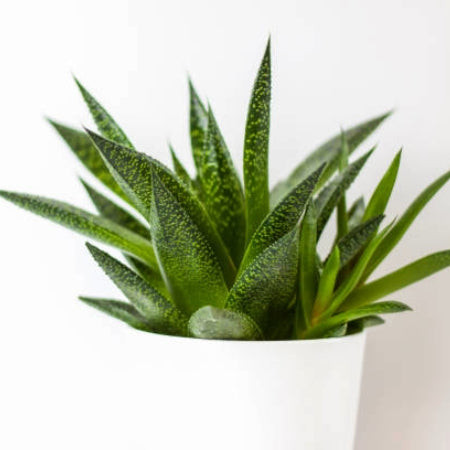 Ox Tongue Plant (Gasteria spp.) with textured, tongue-shaped leaves, a unique and cat-safe succulent.
Ox Tongue Plant (Gasteria spp.) with textured, tongue-shaped leaves, a unique and cat-safe succulent.
16. Ox Tongue Plant (Gasteria spp.)
Key Features:
- Toxicity: Non-toxic to cats and dogs
- Watering: Low; extremely drought-tolerant
- Size: Up to 24 inches tall and 12 inches wide
- Light: Bright, indirect light
Ox Tongue Plants (Gasteria spp.) are unique, pet-safe succulents from South Africa. They feature distinctive flat, textured leaves with white and green patterns. Gasterias thrive in bright, indirect light and produce unique pinkish-green flowers, adding an unusual charm to your collection of cat friendly indoor plants.
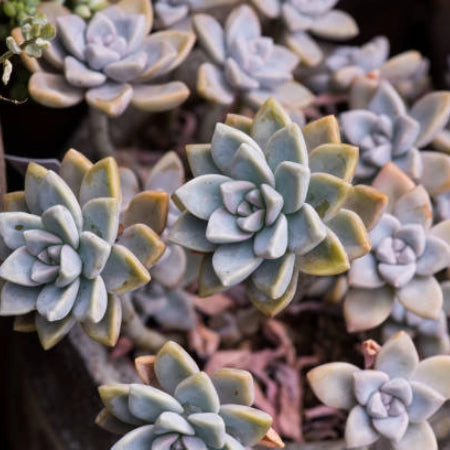 Variegated Ghost Plant (Graptopetalum Paraguayense Variegata) with pastel variegated leaves, a subtle and cat-safe succulent.
Variegated Ghost Plant (Graptopetalum Paraguayense Variegata) with pastel variegated leaves, a subtle and cat-safe succulent.
17. Variegated Ghost Plant (Graptopetalum Paraguayense Variegata)
Key Features:
- Toxicity: Non-toxic to cats and dogs
- Watering: Low; extremely drought-tolerant
- Size: Up to 12 inches long and 6 inches wide
- Light: Full sun to partial shade
The Variegated Ghost Plant (Graptopetalum Paraguayense Variegata) is a subtly beautiful succulent with pastel variegated leaves in shades of green and creamy white. This low-light tolerant and cat-safe plant adds a soft touch of color and texture to your home, while being perfectly safe for your feline companions.
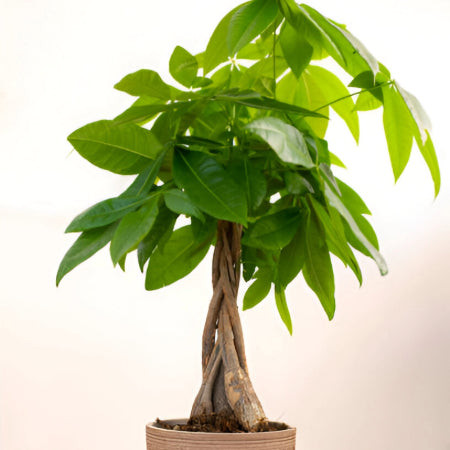 Money Tree (Pachira aquatica) with braided trunk and palmate leaves, a symbolic and cat-safe houseplant.
Money Tree (Pachira aquatica) with braided trunk and palmate leaves, a symbolic and cat-safe houseplant.
18. Money Tree (Pachira aquatica)
Key Features:
- Toxicity: Non-toxic to cats and dogs
- Watering: Moderate; allow soil surface to dry between watering
- Size: Variable, from small houseplants to larger trees
- Light: Partial shade to bright indirect light
The Money Tree (Pachira aquatica) is believed to bring good luck and fortune and is also a low-maintenance, cat-safe houseplant. With its distinctive braided trunk and lush, palmate leaves, it adds a touch of elegance and symbolism to your indoor space. This plant thrives in partial shade, making it suitable for various rooms in your home.
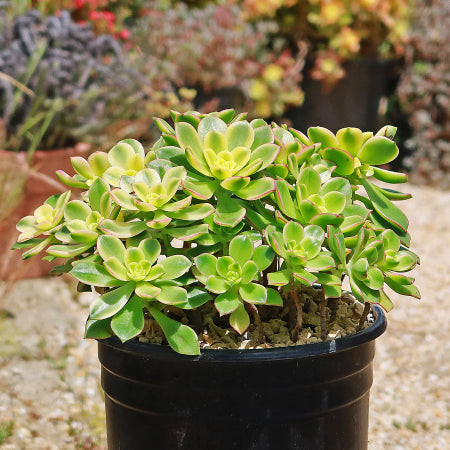 Aeonium haworthii 'Kiwi' with vibrant green and pink rosettes, a colorful and cat-safe succulent.
Aeonium haworthii 'Kiwi' with vibrant green and pink rosettes, a colorful and cat-safe succulent.
19. Aeonium haworthii ‘Kiwi’
Key Features:
- Toxicity: Non-toxic to cats and dogs
- Watering: Low; extremely drought-tolerant
- Size: Up to 3 feet tall
- Light: Full sun to partial shade
Aeonium haworthii ‘Kiwi’ is a vibrant and easy-care succulent that is also cat safe. Its rosettes feature bright green leaves with striking pinkish edges, adding a pop of color to your plant collection. This low-maintenance plant is perfect for adding visual interest without compromising your cat’s safety.
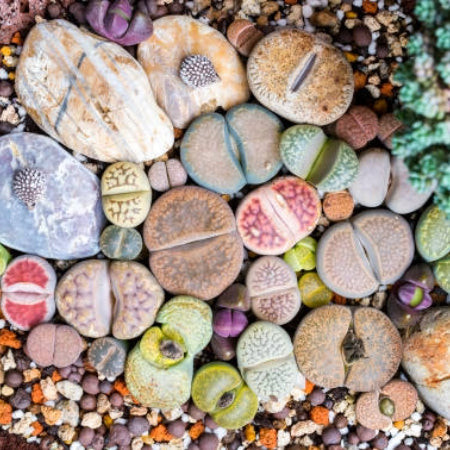 Lithops (Living Stones) succulents resembling pebbles, a unique and cat-safe succulent novelty.
Lithops (Living Stones) succulents resembling pebbles, a unique and cat-safe succulent novelty.
20. Lithops (Living Stones)
Key Features:
- Toxicity: Non-toxic to cats and dogs
- Watering: Very low; water sparingly during growing season
- Size: Up to 4 inches tall and 6 inches wide
- Light: Full sun to partial shade
Lithops, also known as Living Stones, are fascinating succulents that resemble small pebbles or stones. These unique, low-maintenance, and cat-safe plants come in a variety of colors and patterns, adding a touch of novelty and intrigue to your indoor garden.
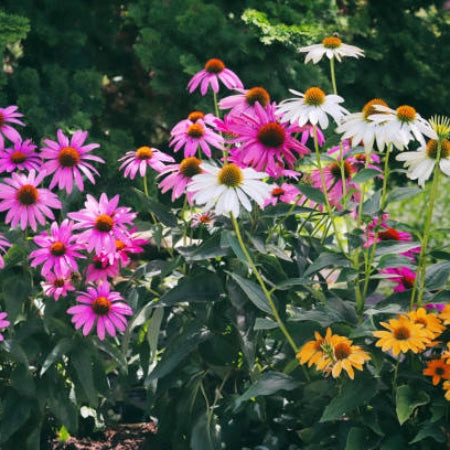 Coneflower (Echinacea) with daisy-like purple flowers, a vibrant and cat-safe garden perennial.
Coneflower (Echinacea) with daisy-like purple flowers, a vibrant and cat-safe garden perennial.
21. Coneflower (Echinacea)
Key Features:
- Toxicity: Non-toxic to cats and dogs
- Watering: Low; drought-resistant once established
- Size: Up to 15 feet tall (likely a typo in original, more commonly 1-5 feet)
- Light: Full sun to partial shade
Coneflower (Echinacea) is a resilient and vibrant perennial with daisy-like flowers in shades of pink, purple, white, and yellow. This cat-safe plant is drought-tolerant once established and attracts pollinators like bees and butterflies, adding ecological value to your garden or outdoor space.
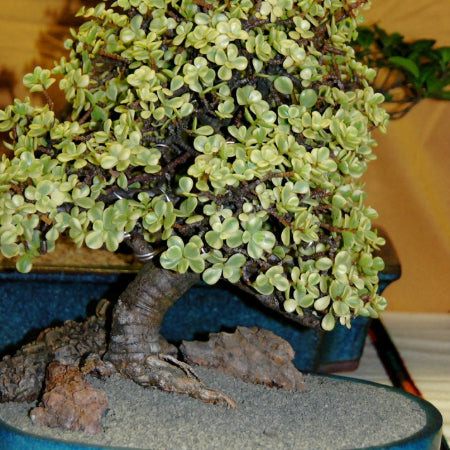 Rainbow Bush (Portulacaria afra variegata) with colorful variegated foliage, an easy-care and cat-safe succulent shrub.
Rainbow Bush (Portulacaria afra variegata) with colorful variegated foliage, an easy-care and cat-safe succulent shrub.
22. Rainbow Bush (Portulacaria afra variegata)
Key Features:
- Toxicity: Non-toxic to cats and dogs
- Watering: Low; extremely drought-tolerant
- Size: Up to 10 feet tall
- Light: Full sun to partial shade
Rainbow Bush (Portulacaria afra variegata) is an easy-care succulent shrub with vibrant, variegated leaves in shades of green, pink, and cream. This cat-safe plant is often used for bonsai or grown in containers. Its colorful foliage and low-maintenance nature make it a great choice for plant enthusiasts and cat owners.
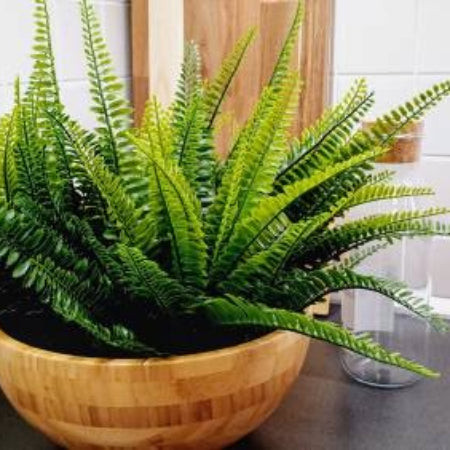 Boston Fern (Nephrolepis exaltata) with lush green fronds, a classic and cat-safe fern for humid environments.
Boston Fern (Nephrolepis exaltata) with lush green fronds, a classic and cat-safe fern for humid environments.
23. Boston Fern (Nephrolepis exaltata)
Key Features:
- Toxicity: Non-toxic to cats and dogs
- Watering: Moderate; keep soil consistently moist
- Size: Fronds up to 3 feet wide
- Light: Partial shade to bright indirect light
Boston Fern (Nephrolepis exaltata) is a classic and popular houseplant with lush, shaggy fronds. This cat-safe fern thrives in humid environments and bright, indirect light, making it a great choice for bathrooms or well-lit rooms. Its air-purifying qualities and pet-friendly nature make it a wonderful addition to any home.
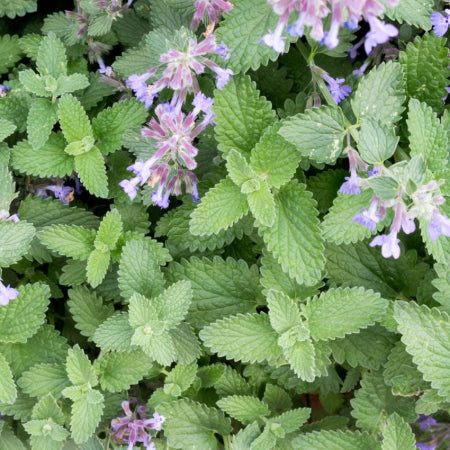 Catnip (Nepeta cataria) with green leaves and white flowers, a stimulating and cat-safe herb beloved by felines.
Catnip (Nepeta cataria) with green leaves and white flowers, a stimulating and cat-safe herb beloved by felines.
24. Catnip (Nepeta cataria)
Key Features:
- Toxicity: Non-toxic to cats and dogs
- Watering: Low; drought-resistant
- Size: Up to 3 feet tall
- Light: Full sun to partial shade
Catnip (Nepeta cataria) is a well-known herb that is safe for cats and highly stimulating to them. While it may induce playful behavior in cats, it is completely harmless and non-toxic. Catnip is easy to grow indoors or outdoors and features attractive green leaves and white, pink, or purple flowers, making it a fun and cat-friendly addition to your home.
![]() Cat Grass (Dactylis glomerata) fresh and green, a healthy and cat-safe treat for feline digestion.
Cat Grass (Dactylis glomerata) fresh and green, a healthy and cat-safe treat for feline digestion.
25. Cat Grass (Dactylis glomerata)
Key Features:
- Toxicity: Non-toxic to cats and dogs
- Watering: Moderate; keep soil consistently moist
- Size: Up to 8 inches tall
- Light: Full sun to partial shade
Cat Grass (Dactylis glomerata) is a healthy and safe treat for cats. Similar to oat grass, it is specifically grown for feline consumption. Cat grass aids in digestion and can help prevent hairballs, making it a beneficial and cat-friendly addition to your indoor environment.
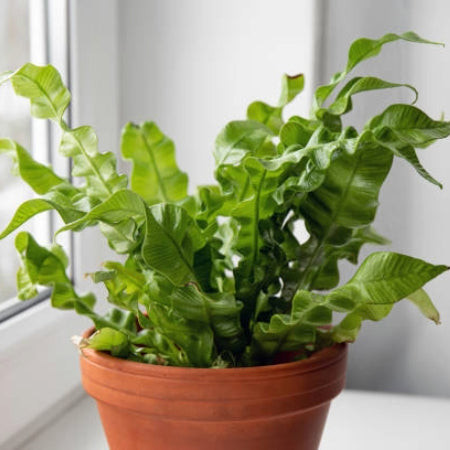 Bird's Nest Fern (Asplenium nidus) with nest-like fronds, a unique and cat-safe fern for indoor spaces.
Bird's Nest Fern (Asplenium nidus) with nest-like fronds, a unique and cat-safe fern for indoor spaces.
26. Bird’s Nest Fern (Asplenium nidus)
Key Features:
- Toxicity: Non-toxic to cats and dogs
- Watering: Moderate; keep soil consistently moist
- Size: Up to 2 feet tall indoors, 5 feet outdoors
- Light: Partial shade to bright indirect light
Bird’s Nest Fern (Asplenium nidus) is a beautiful and pet-friendly fern with unique, nest-like fronds. This non-toxic plant adds a touch of tropical elegance to any room and is relatively low-maintenance, thriving in various lighting conditions.
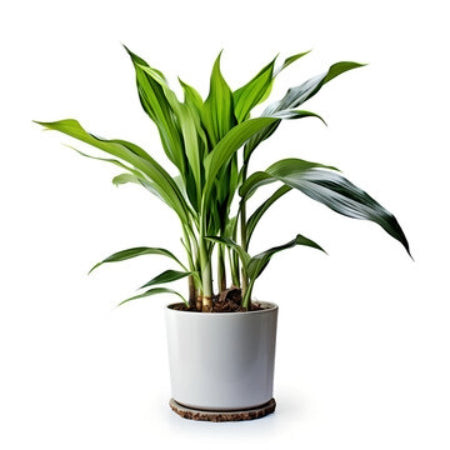 Cast Iron Plant (Aspidistra elatior) with large oval leaves, a resilient and cat-safe plant for low-light conditions.
Cast Iron Plant (Aspidistra elatior) with large oval leaves, a resilient and cat-safe plant for low-light conditions.
27. Cast Iron Plant (Aspidistra elatior)
Key Features:
- Toxicity: Non-toxic to cats and dogs
- Watering: Low; drought-tolerant
- Size: Up to 2 feet tall
- Light: Low to partial shade
The Cast Iron Plant (Aspidistra elatior) is known for its incredible resilience and ability to thrive in low-light conditions. This easy-care, cat-safe plant features large, oval leaves that brighten up indoor spaces, even in dimly lit corners.
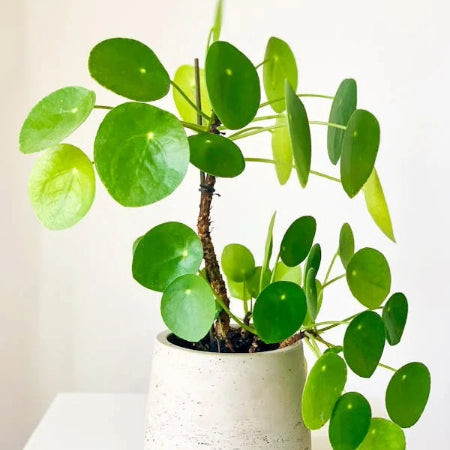 Chinese Money Plant (Pilea peperomioides) with coin-shaped leaves, a trendy and cat-safe plant for indirect light.
Chinese Money Plant (Pilea peperomioides) with coin-shaped leaves, a trendy and cat-safe plant for indirect light.
28. Chinese Money Plant (Pilea peperomioides)
Key Features:
- Toxicity: Non-toxic to cats and dogs
- Watering: Moderate; allow soil surface to dry between watering
- Size: Up to 12 inches tall and wide
- Light: Partial shade to bright indirect light
The Chinese Money Plant (Pilea peperomioides) is a trendy houseplant with unique, disc-shaped leaves. This vibrant green, cat-safe plant thrives in bright, indirect light and tolerates occasional neglect, making it a stylish and low-maintenance choice for cat owners.
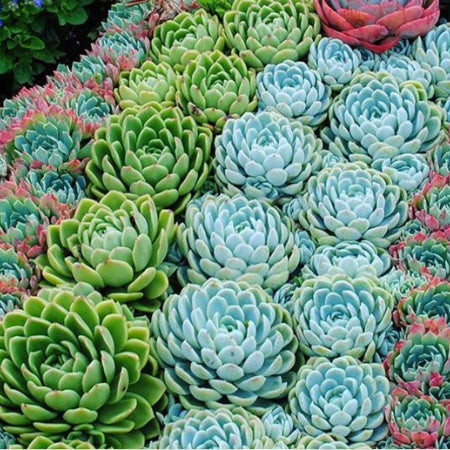 Hens and Chicks (Sempervivum tectorum) rosettes clustered together, a hardy and cat-safe succulent ground cover.
Hens and Chicks (Sempervivum tectorum) rosettes clustered together, a hardy and cat-safe succulent ground cover.
29. Hens and Chicks (Sempervivum tectorum)
Key Features:
- Toxicity: Non-toxic to cats and dogs
- Watering: Low; extremely drought-tolerant
- Size: Rosettes up to 3 inches wide, clusters can spread wider
- Light: Full sun to partial shade
Hens and Chicks (Sempervivum tectorum) are hardy and charming succulents known for their rosette-shaped leaves and ability to produce offsets (“chicks”). These cat-safe plants are extremely drought-tolerant and perfect for rock gardens, containers, or as ground cover.
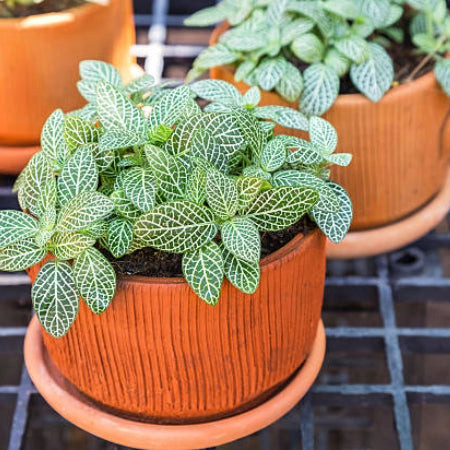 Mosaic Plant (Fittonia albivenis) with striking white-veined leaves, a humidity-loving and cat-safe foliage plant.
Mosaic Plant (Fittonia albivenis) with striking white-veined leaves, a humidity-loving and cat-safe foliage plant.
30. Mosaic Plant (Fittonia albivenis)
Key Features:
- Toxicity: Non-toxic to cats and dogs
- Watering: Moderate; keep soil consistently moist
- Size: Up to 6 inches tall and 18 inches wide
- Light: Partial to full shade
Mosaic Plant (Fittonia albivenis), also known as Nerve Plant, features beautifully veined leaves in white or pink. This rainforest native is non-toxic to cats and dogs and thrives in humid environments and low-light conditions, making it a good choice for bathrooms or terrariums.
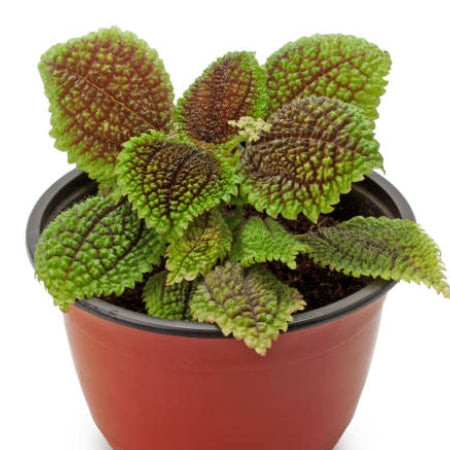 Friendship Plant (Pilea involucrata) with textured, quilted leaves, a unique and cat-safe terrarium plant.
Friendship Plant (Pilea involucrata) with textured, quilted leaves, a unique and cat-safe terrarium plant.
31. Friendship Plant (Pilea involucrata)
Key Features:
- Toxicity: Non-toxic to cats and dogs
- Watering: Moderate; keep soil consistently moist
- Size: Up to 12 inches tall and wide
- Light: Partial shade to bright indirect light
Friendship Plant (Pilea involucrata) is a unique and textured plant with fragile stems and quilted leaves. This pet-friendly plant thrives in high humidity and indirect light, making it ideal for terrariums or enclosed environments.
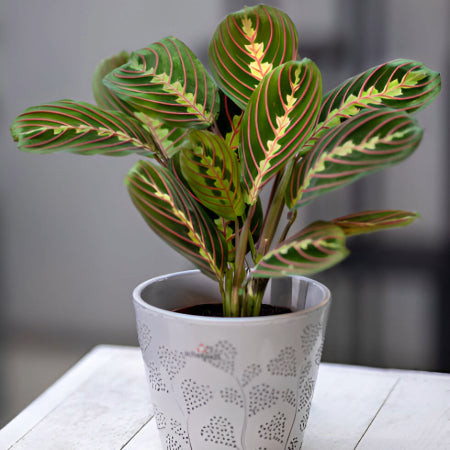 Prayer Plant (Maranta leuconeura) with patterned leaves folded upwards, a dynamic and cat-safe plant with leaf movement.
Prayer Plant (Maranta leuconeura) with patterned leaves folded upwards, a dynamic and cat-safe plant with leaf movement.
32. Prayer Plant (Maranta leuconeura)
Key Features:
- Toxicity: Non-toxic to cats and dogs
- Watering: Moderate; keep soil consistently moist
- Size: Up to 15 inches tall and wide
- Light: Partial shade to bright indirect light
Prayer Plant (Maranta leuconeura) is known for its fascinating leaf movement, folding its patterned leaves upwards at night, resembling praying hands. This tropical foliage plant is non-toxic to pets and thrives in bright, indirect light and consistently moist soil.
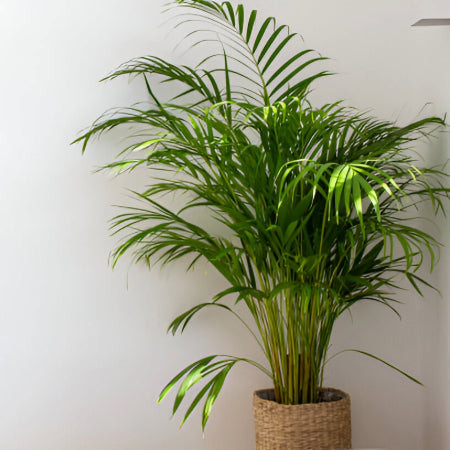 Areca Palm (Dypsis lutescens) with feathery fronds, a tropical and cat-safe palm for bright spaces.
Areca Palm (Dypsis lutescens) with feathery fronds, a tropical and cat-safe palm for bright spaces.
33. Areca Palm (Dypsis lutescens)
Key Features:
- Toxicity: Non-toxic to cats and dogs
- Watering: Moderate; allow soil surface to dry slightly between watering
- Size: Up to 8 feet tall indoors
- Light: Bright, indirect light
Areca Palm (Dypsis lutescens), also known as Butterfly Palm, is a tropical indoor palm that is safe for cats and dogs. It requires bright light and well-draining soil, adding a touch of the tropics to your home while being safe for your feline friends.
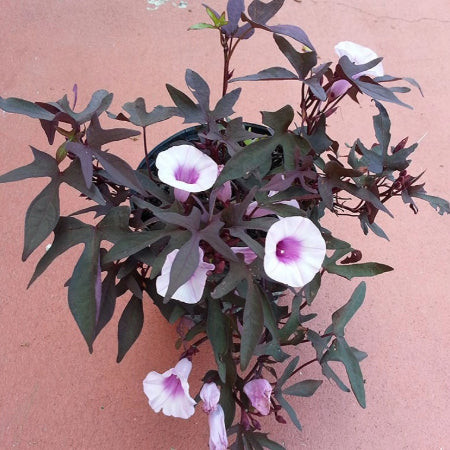 Sweet Potato Vine (Ipomoea batatas) with vibrant purple heart-shaped leaves, a colorful and cat-safe vine for gardens and containers.
Sweet Potato Vine (Ipomoea batatas) with vibrant purple heart-shaped leaves, a colorful and cat-safe vine for gardens and containers.
34. Sweet Potato Vine (Ipomoea batatas)
Key Features:
- Toxicity: Non-toxic to cats and dogs
- Watering: Moderate; drought-resistant once established
- Size: Vines can reach 10 feet long
- Light: Full sun to partial shade
Sweet Potato Vine (Ipomoea batatas) is a versatile and beautiful ornamental vine with vibrant, heart-shaped leaves in various colors. This non-toxic plant is safe for cats and dogs and adds a lush, cascading effect to gardens, hanging baskets, or container arrangements.
Tips for Keeping Cats and Plants Happy Together
Creating a harmonious environment for both your feline friends and houseplants involves a few simple strategies. Choosing non-toxic plants is the first and most crucial step, but here are some additional tips to ensure a purrfectly plant-filled and pet-safe home:
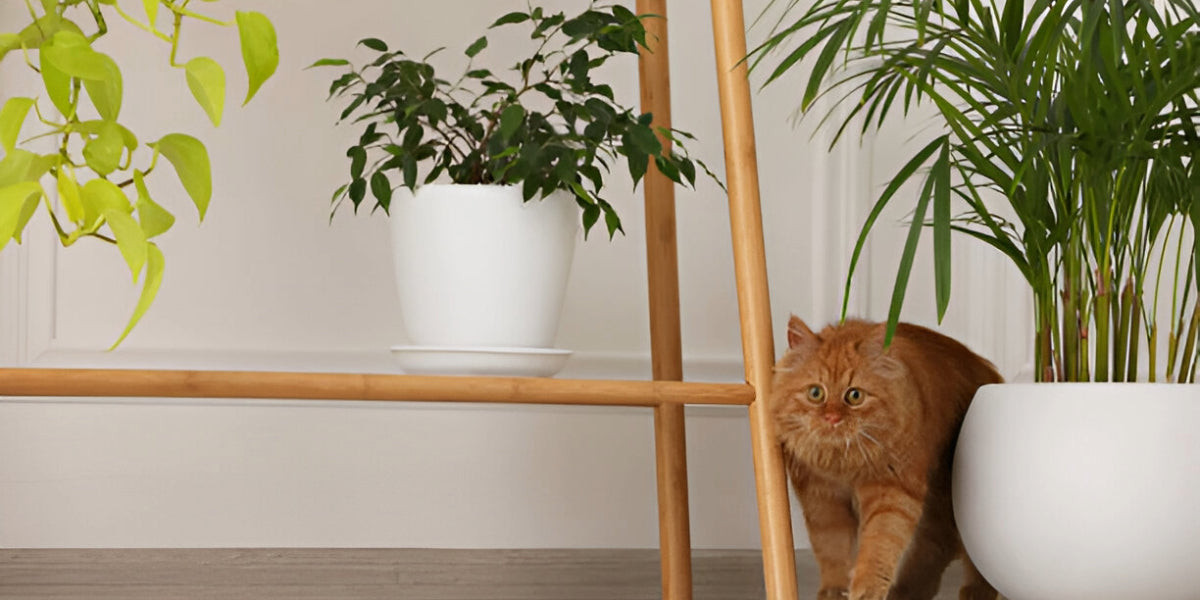 Cat looking at houseplants, emphasizing the importance of non-toxic plant choices for pet safety.
Cat looking at houseplants, emphasizing the importance of non-toxic plant choices for pet safety.
Elevate and Protect
Consider placing your houseplants on shelves, hanging baskets, or plant stands to keep them out of easy reach of curious cats. This not only protects your plants from curious paws but also adds vertical interest to your home decor.
Deterrents and Diversions
If your cat is particularly drawn to plants, provide them with alternatives they can enjoy, such as cat grass or catnip. You can also use natural deterrents like citrus peels or commercially available pet-safe plant sprays to discourage nibbling.
Regular Plant Maintenance
Remove any dead or fallen leaves promptly. Decomposing plant matter can be tempting for cats to ingest and might cause stomach upset, even from non-toxic plants. Regularly check your plants for any signs of damage from curious cats.
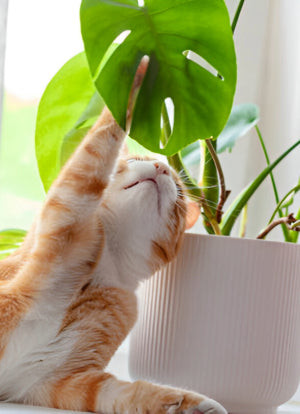 Cat nibbling on a houseplant, highlighting the need for preventative measures and cat-safe options.
Cat nibbling on a houseplant, highlighting the need for preventative measures and cat-safe options.
Sunlight and Water Wisdom
Ensure your plants receive adequate sunlight by placing them in well-lit areas. If natural light is limited, consider using grow lights. Avoid overwatering, as stagnant water can be harmful to both plants and pets. Always drain excess water from saucers to prevent your cat from drinking it and potentially ingesting fertilizer runoff or bacteria.
Pet-Safe Fertilizers
When fertilizing your plants, opt for pet-safe or organic fertilizers. Keep all fertilizers and chemicals stored securely and out of reach of your cats.
Low-Maintenance is Key
The cat friendly plants listed above are not only safe for your pets but also selected for their ease of care. Many are drought-tolerant and can withstand occasional missed waterings, perfect for busy lifestyles or those new to plant care. Succulents, in particular, are known for their resilience and ability to thrive with minimal attention.
Creative Display Ideas for Cat-Friendly Greenery
Integrating cat-safe plants into your home decor can be both stylish and functional. Here are some creative display ideas:
Vertical Gardens
Create a living wall with a variety of cat-safe plants in different pots and sizes. Vertical gardens are space-saving and add a dramatic green feature to any room.
Window Shelves
Install shelves near windows to create a bright and sunny plant display. This is ideal for plants that love light and provides your cat with a stimulating view.
Hanging Baskets
Hang baskets from ceilings or hooks to showcase trailing cat-safe plants. Hanging plants add visual interest and keep plants out of reach of ground-level explorers.
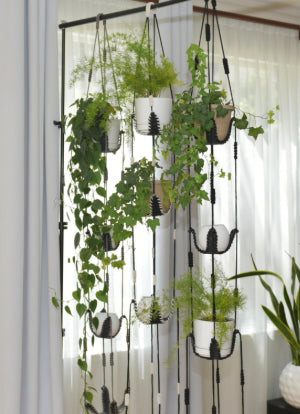 Vertical garden with various plants, inspiring creative and safe plant displays in a cat-friendly home.
Vertical garden with various plants, inspiring creative and safe plant displays in a cat-friendly home.
Terrariums
Create miniature enclosed gardens in terrariums. Terrariums are perfect for humidity-loving cat-safe plants and add a unique decorative element.
Where to Find Your Cat Friendly Plants
Many of the plants listed in this guide are available at Planet Desert online. You may also find some of these cat safe houseplants at your local nurseries. Calling ahead to check availability is always recommended, as local nurseries may have a rotating stock.
![]() Planet Desert logo, directing readers to a source for purchasing cat-friendly plants online.
Planet Desert logo, directing readers to a source for purchasing cat-friendly plants online.
Final Thoughts: A Safe and Stylish Green Home
Creating a cat-friendly home doesn’t mean sacrificing your love for plants. By choosing non-toxic options and implementing a few preventative measures, you can enjoy a beautiful, green indoor space that is safe and enjoyable for both you and your feline companions. Embrace these cat friendly plants and create a purrfectly harmonious home.
Frequently Asked Questions about Cat Friendly Plants
Is Aloe Vera safe for cats?
No, Aloe Vera is not safe for cats. It contains compounds that are toxic to felines if ingested. It’s best to avoid Aloe Vera and choose from the many other beautiful cat-safe alternatives.
Why are some houseplants toxic to cats but not other animals?
Cats are particularly sensitive to certain plant toxins, such as alkaloids and glycosides, which are found in many common houseplants like lilies and sago palms. These compounds can negatively affect a cat’s digestive and nervous systems. Other animals may metabolize these substances differently, making them less susceptible to toxicity. Always research plant safety specifically for cats.
Are all succulents poisonous to cats?
No, not all succulents are poisonous to cats. Many succulents are perfectly safe for cats, and this list highlights numerous cat-friendly succulent options. However, some succulents, like Euphorbia species and some Jade plants, can be toxic. Always identify succulents by name and verify their safety before bringing them into a home with cats.
What should I do if I think my cat has eaten a toxic plant?
- Stay calm.
- Identify the plant if possible and estimate how much was ingested.
- Contact your veterinarian or the ASPCA Animal Poison Control Center immediately. Time is critical in treating plant poisoning.
- Do not induce vomiting unless specifically instructed to do so by a veterinarian.
- Bring a sample of the plant with you to the vet if possible.
It’s always better to err on the side of caution. If you suspect your cat has ingested any part of a toxic plant, seek veterinary help immediately.
